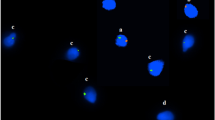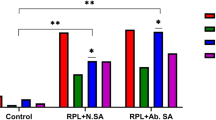Abstract
Purpose
To evaluate whether the morphologically normal spermatozoa selected for intracytoplasmic sperm injection (ICSI) under microscope had a higher rate of normal/balanced chromosome contents than that in the whole unselected sperm from reciprocal translocation carriers.
Methods
Five hundred unselected spermatozoa from each of 40 male translocation carriers were performed with fluorescence in situ hybridization (FISH), to determine the rates of gametes with different meiotic contents of translocated chromosomes. Meanwhile, 3030 biopsied blastocysts from 239 male and 293 female reciprocal translocation carriers were detected with the microarray technique to analyze the rates of embryos with different translocated chromosome contents.
Results
The D3 embryo rate, blastocyst formation rate, and euploid rate of blastocysts were remarkably higher in male carriers than those in female (p = 0.001, p = 0.004, and p = 0.035, respectively). In addition, the percentages of alternate products, which contained normal/balanced chromosome contents, in embryos from male carriers were markedly higher than those in sperm FISH (p = 2.48 × 10−5 and p = 2.88 × 10−10), while the percentages of adjacent-2 and 3:1 products were lower than those in sperm FISH (p = 0.003 and p = 5.28 × 10−44). Moreover, consistent results were obtained when comparing the rates of products in embryos between male and female carriers. Specifically, the incidence of alternate products in male carriers was higher than those in female carriers (p = 0.022). However, no similar differences were seen between sperm and embryos of female carriers.
Conclusion
ICSI facilitates the selection of spermatozoa with normal/balanced chromosome contents and improves the D3 embryo rate, blastocyst formation rate, and the euploid embryo rate in male carriers.


Similar content being viewed by others

References
Palermo G, Joris H, Devroey P, Van Steirteghem AC. Pregnancies after intracytoplasmic injection of single spermatozoon into an oocyte. Lancet. 1992;340(8810):17–8.
Menkveld R, Holleboom CA, Rhemrev JP. Measurement and significance of sperm morphology. Asian J Androl. 2011;13(1):59–68.
Clementini E, Palka C, Iezzi I, Stuppia L, Guanciali-Franchi P, Tiboni GM. Prevalence of chromosomal abnormalities in 2078 infertile couples referred for assisted reproductive techniques. Hum Reprod. 2005;20(2):437–42.
Zhang HG, Wang RX, Li LL, Sun WT, Zhang HY, Liu RZ. Male carriers of balanced reciprocal translocations in Northeast China: sperm count, reproductive performance, and genetic counseling. Genet Mol Res. 2015;14(4):18792–8.
Ananthapur V, Avvari S, Veena K, Sujatha M, Jyothy A. Non-Robertsonian translocation t (2;11) is associated with infertility in an oligospermic man. Andrologia. 2014;46(4):453–5.
Fiorentino F, Spizzichino L, Bono S, Biricik A, Kokkali G, Rienzi L, et al. PGD for reciprocal and Robertsonian translocations using array comparative genomic hybridization. Hum Reprod. 2011;26(7):1925–35.
Zhang Y, Zhu S, Wu J, Liu S, Sun X. Quadrivalent asymmetry in reciprocal translocation carriers predicts meiotic segregation patterns in cleavage stage embryos. Reprod BioMed Online. 2014;29(4):490–8.
Scriven PN, Handyside AH, Ogilvie CM. Chromosome translocations: segregation modes and strategies for preimplantation genetic diagnosis. Prenat Diagn. 1998;18(13):1437–49.
Vozdova M, Oracova E, Horinova V, Rubes J. Sperm fluorescence in situ hybridization study of meiotic segregation and an interchromosomal effect in carriers of t(11;18). Hum Reprod. 2008;23(3):581–8.
Kekesi A, Erdei E, Torok M, Dravucz S, Toth A. Segregation of chromosomes in spermatozoa of four Hungarian translocation carriers. Fertil Steril. 2007;88(1):212–5.
Xie Y, Xu Y, Wang J, Miao B, Zeng Y, Ding C, et al. Preliminary analysis of numerical chromosome abnormalities in reciprocal and Robertsonian translocation preimplantation genetic diagnosis cases with 24-chromosomal analysis with an aCGH/SNP microarray. J Assist Reprod Genet. 2018;35(1):177–86.
Chow J, Yeung W, Lee V, Lau E, Ng E. Evaluation of preimplantation genetic testing for chromosomal structural rearrangement by a commonly used next generation sequencing workflow. Eur J Obstet Gynecol Reprod Biol. 2018;224:66–73.
Chelli MH, Ferfouri F, Boitrelle F, Albert M, Molina-Gomes D, Selva J, et al. High-magnification sperm selection does not decrease the aneuploidy rate in patients who are heterozygous for reciprocal translocations. J Assist Reprod Genet. 2013;30(4):525–30.
Wilding M, Coppola G, di Matteo L, Palagiano A, Fusco E, Dale B. Intracytoplasmic injection of morphologically selected spermatozoa (IMSI) improves outcome after assisted reproduction by deselecting physiologically poor quality spermatozoa. J Assist Reprod Genet. 2011;28(3):253–62.
Bartoov B, Berkovitz A, Eltes F, Kogosovsky A, Yagoda A, Lederman H, et al. Pregnancy rates are higher with intracytoplasmic morphologically selected sperm injection than with conventional intracytoplasmic injection. Fertil Steril. 2003;80(6):1413–9.
Antinori M, Licata E, Dani G, Cerusico F, Versaci C, D'Angelo D, et al. Intracytoplasmic morphologically selected sperm injection: a prospective randomized trial. Reprod BioMed Online. 2008;16(6):835–41.
Calogero AE, Burrello N, De Palma A, Barone N, D'Agata R, Vicari E. Sperm aneuploidy in infertile men. Reprod BioMed Online. 2003;6(3):310–7.
Chantot-Bastaraud S, Ravel C, Berthaut I, McElreavey K, Bouchard P, Mandelbaum J, et al. Sperm-FISH analysis in a pericentric chromosome 1 inversion, 46,XY,inv(1)(p22q42), associated with infertility. Mol Hum Reprod. 2007;13(1):55–9.
Benet J, Oliver-Bonet M, Cifuentes P, Templado C, Navarro J. Segregation of chromosomes in sperm of reciprocal translocation carriers: a review. Cytogenet Genome Res. 2005;111(3–4):281–90.
Anton E, Vidal F, Blanco J. Role of sperm FISH studies in the genetic reproductive advice of structural reorganization carriers. Hum Reprod. 2007;22(8):2088–92.
Martin RH. Cytogenetic determinants of male fertility. Hum Reprod Update. 2008;14(4):379–90.
Fan JB, Hu S, Craumer W, Barker D. BeadArray-based solutions for enabling the promise of pharmacogenomics. Biotechniques. 2005;39(10 Suppl):S583–8.
Anton E, Vidal F, Blanco J. Reciprocal translocations: tracing their meiotic behavior. Genet Med. 2008;10(10):730–8.
Lledo B, Ortiz JA, Morales R, Ten J, de la Fuente PE, Garcia-Ochoa C, et al. The paternal effect of chromosome translocation carriers observed from meiotic segregation in embryos. Hum Reprod. 2010;25(7):1843–8.
Ko DS, Cho JW, Park SY, Kim JY, Koong MK, Song IO, et al. Clinical outcomes of preimplantation genetic diagnosis (PGD) and analysis of meiotic segregation modes in reciprocal translocation carriers. Am J Med Genet A. 2010;152A(6):1428–33.
Yakut T, Ercelen N, Acar H, Kimya Y, Egeli U. Meiotic segregation analysis of reciprocal translocations both in sperms and blastomeres. Am J Med Genet A. 2006;140(10):1074–82.
Cassuto NG, Le Foll N, Chantot-Bastaraud S, Balet R, Bouret D, Rouen A, et al. Sperm fluorescence in situ hybridization study in nine men carrying a Robertsonian or a reciprocal translocation: relationship between segregation modes and high-magnification sperm morphology examination. Fertil Steril. 2011;96(4):826–32.
Celik-Ozenci C, Jakab A, Kovacs T, Catalanotti J, Demir R, Bray-Ward P, et al. Sperm selection for ICSI: shape properties do not predict the absence or presence of numerical chromosomal aberrations. Hum Reprod. 2004;19(9):2052–9.
Keymolen K, Staessen C, Verpoest W, Liebaers I, Bonduelle M. Preimplantation genetic diagnosis in female and male carriers of reciprocal translocations: clinical outcome until delivery of 312 cycles. Eur J Hum Genet. 2012;20(4):376–80.
Ko DS, Cho JW, Lee HS, Kim JY, Kang IS, Yang KM, et al. Preimplantation genetic diagnosis outcomes and meiotic segregation analysis of robertsonian translocation carriers. Fertil Steril. 2013;99(5):1369–76.
Ishikawa T, Shiotani M, Izumi Y, Hashimoto H, Kokeguchi S, Goto S, et al. Fertilization and pregnancy using cryopreserved testicular sperm for intracytoplasmic sperm injection with azoospermia. Fertil Steril. 2009;92(1):174–9.
Caseiro AL, Regalo A, Pereira E, Esteves T, Fernandes F, Carvalho J. Implication of sperm chromosomal abnormalities in recurrent abortion and multiple implantation failure. Reprod BioMed Online. 2015;31(4):481–5.
Vozdova M, Kasikova K, Oracova E, Prinosilova P, Rybar R, Horinova V, et al. The effect of the swim-up and hyaluronan-binding methods on the frequency of abnormal spermatozoa detected by FISH and SCSA in carriers of balanced chromosomal translocations. Hum Reprod. 2012;27(3):930–7.
Yin B, Zhu Y, Wu T, Shen S, Zeng Y, Liang D. Clinical outcomes for couples containing a reciprocal chromosome translocation carrier without preimplantation genetic diagnosis. Int J Gynaecol Obstet. 2017;136(3):304–8.
Baumgartner A, Van Hummelen P, Lowe XR, Adler ID, Wyrobek AJ. Numerical and structural chromosomal abnormalities detected in human sperm with a combination of multicolor FISH assays. Environ Mol Mutagen. 1999;33(1):49–58.
Alfarawati S, Fragouli E, Colls P, Wells D. Embryos of robertsonian translocation carriers exhibit a mitotic interchromosomal effect that enhances genetic instability during early development. PLoS Genet. 2012;8(10):e1003025.
Zhang S, Lei C, Wu J, Sun H, Zhou J, Zhu S, et al. Analysis of segregation patterns of quadrivalent structures and the effect on genome stability during meiosis in reciprocal translocation carriers. Hum Reprod. 2018;33(4):757–67.
Estop AM, Cieply K, Munne S, Surti U, Wakim A, Feingold E. Is there an interchromosomal effect in reciprocal translocation carriers? Sperm FISH studies. Hum Genet. 2000;106(5):517–24.
Acknowledgments
We express deepest gratitude to all the families enrolled in our research. We also thank the staff of the Genetics Laboratory and IVF Laboratory for their invaluable efforts and contribution relating to the experiment.
Funding
The research was supported by the Science and Technology Innovation Action Plan Program of Shanghai (18411953800) and Shanghai Shen Kang Hospital Development Centre Municipal Hospital New Frontier Technology Joint Project (SHDC12017105).
Author information
Authors and Affiliations
Contributions
C.L, S.Z, and X.S designed the research and wrote the manuscript; C.L, S.Z, SJ.Z, J.W, M.X, J.Z, J.F, Y.S X.S, and C.L executed the research and data collection (S.Z, M.X, C.L, and M.X performed the analysis; S.Z, SJ.Z, and J.Z performed the microarray experiments and SJ.Z performed the FISH experiments; J.F and Y.S performed the intra-cytoplasmic sperm injection and blastocyst biopsy experiments; J.W, X.S, and C.L collected the cases). X.S and C.C directed the critical discussion of the manuscript. All authors approved the final manuscript.
Corresponding author
Ethics declarations
The study protocol was approved by the Ethics Committee of Human Subject Research of the Obstetrics and Gynecology Hospital, Fudan University.
Conflict of interest
The authors declare that they have no conflict of interest.
Informed consent
Informed consents were obtained from all individual participants included in the study.
Additional information
Publisher’s note
Springer Nature remains neutral with regard to jurisdictional claims in published maps and institutional affiliations.
Rights and permissions
About this article
Cite this article
Lei, C., Zhang, S., Zhu, S. et al. Conventional ICSI improves the euploid embryo rate in male reciprocal translocation carriers. J Assist Reprod Genet 38, 129–138 (2021). https://doi.org/10.1007/s10815-020-02013-z
Received:
Accepted:
Published:
Issue Date:
DOI: https://doi.org/10.1007/s10815-020-02013-z



